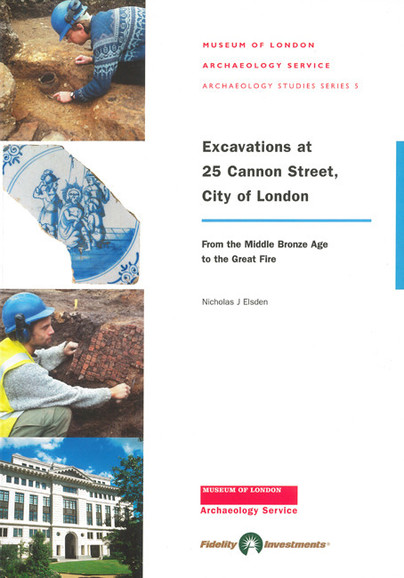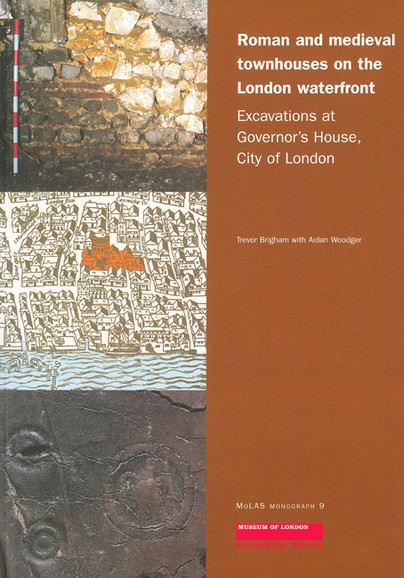In the last decade MOLA published over 90 academic and popular books and manuals, and has developed processes to ensure the highest standards. Publications include both English Heritage- and developer-funded work but have been joined by significant work for other clients, who are using MOLA as a publishing outlet for their own work.
MOLA's Monograph and Studies Series have in general developed a common structure: an introduction; a chronological narrative describing the site sequence interwoven with the specialists’ evidence; thematic chapters; conclusions; and appendices with supporting data which cater for the specialist reader; these data are supplemented by CD-ROMs and online resources. The integrated approach requires a high level of collaboration and dialogue among the project team, and a focus on strong research aims within regional and national research frameworks and strategies. The research aims are set out before fieldwork begins and are revised at the assessment stage. This approach is underpinned and facilitated by their in-house team, supplemented by experts based in academic institutions. It also requires high levels of IT expertise in their developing relational database and geographic information system (GIS). Quality assurance is essential, supported by MOLA's in-house Managing Editor. Finally the graphics and photography teams ensure high-quality illustrations and products that convey information with maximum clarity. The success of the integrated approach and the quality of the publications is conveyed in many positive reviews written by peers in archaeological journals and news items. As well as the many books MOLA also submit numerous articles to local, regional and national peer-reviewed journals. These papers are just as important to the publisher and their clients, and deliver the results of archaeological work to the target audience as required by both client and curator.In the last decade MOLA published over 90 academic and popular books and manuals, and has developed processes to ensure the highest standards. Publications include both English Heritage- and developer-funded work but have been joined by significant work for other clients, who are using MOLA as a publishing outlet for their own work.

Format: Paperback
Pages: 122
ISBN: 9781901992175
Pub Date: 01 Dec 2002
Series: MoLAS Monograph
Illustrations: 81 b/w illus
Description:
Excavations at the site of Baltic House uncovered evidence of occupation dating from Roman times onward. The earliest excavated feature was a Roman barrel-lined well dated AD 50-80 and containing the skulls of a horse and bull - perhaps a sacrificial offering. The well lay to the south of a large V-shaped ditch which formed part of a late 1st-century defensive boundary along the northeast side of the Roman settlement.
A 2nd-century cellared building was also recorded here. In the medieval period the site lay in an area surrounded by a religious houses. The earliest medieval finds dated from the 10th or 11th century. Industrial activity between the 13th and 15th centuries included metalworking, represented by the manufacture of bells and kitchen vessels, and nitric acid distillation.In the 18th century the area was redeveloped with the creation of Jeffrey Square and smart terraced houses. At the end of the 19th century the Baltic Mercantile and Shipping Exchange was constructed. The building was badly damaged by a terrorist bomb in 1992, and the site is now occupied by the London headquarters of Swiss Re, a striking new office tower designed by Foster and Partners. This publication summarizes the archaeological sequence and history of one of London's most fascinating sites in a fully illustrated and integrated text.

Format: Paperback
Pages: 73
ISBN: 9781901992229
Pub Date: 01 Dec 2001
Series: MoLAS Archaeology Studies Series
Illustrations: 51 b/w illus
Description:
This report provides a chronological account of excavation findings at 25 Cannon Street, supported by many illustrations and specialist contributions. The dig revealed a long sequence of occupation, and adds to findings made on the site in 1954. Redeposited pottery provided rare evidence for Middle Bronze Age activity in the area of the City of London.
Early Roman quarrying and timber buildings were followed by increased development from c. AD 70. By the late 2nd century the area included masonry buildings, some possessing tessellated floors. Building alignments indicate the route of a Roman road immediately to the north of the site, beneath Watling Street. One Roman building was occupied until the late 4th century, its ruins covered by 'dark earth'. Four cellared buildings had been constructed on the site by the mid 11th century, and pre-dated Friday Street and the Church of St Werburga, later St John the Evangelist. The church was founded between 1098 and 1108, and was rebuilt with a wider chancel in the 13th or 14th century. Medieval and later buildings, cellars and cesspits were associated with occupation up to the Great Fire.

Format: Paperback
Pages: 140
ISBN: 9781901992212
Pub Date: 01 Dec 2001
Series: MoLAS Monograph
Illustrations: 74 b/w illus
Description:
The north bank of the Thames near Cannon Street Station was occupied by some of London's most prominent buildings in both the Roman and Medieval periods. Substantial stone walls revealed at the site in 1969 were initially interpreted as part of a Roman townhouse attached to the 'Governor's Palace' building complex to the west. In 1994-7 new excavations uncovered a prehistoric marsh, a riverside quay dated to AD 84 and a revetment constructed in c.
AD 100-200. Later Roman buildings were recorded on terraces overlooking the Thames. Two of these buildings predated the townhouse, and one of these may have been a goldworker's premises. Important new evidence for the ground plan and use of the later townhouse has revealed that it developed separately from other large Roman buildings to the west. Part of a Tuscan order column recovered from the site suggests that the building had some architectural pretensions and a high status. In the late 4th century the townhouse was demolished and the settlement abandoned. The first evidence of reoccupation at the site took the form of early 11th century pitting succeeded by sunken-floored or cellared buildings. The walls of the 14th century Pountney's Inn, later the Manor of the Rose, were recorded along Suffolk Lane. This volume presents the results of the archaeological work at this important site in a clear chronological narrative supported by many detailed illustrations and specialist reports.

Format: Paperback
Pages: 68
ISBN: 9781901992120
Pub Date: 01 Dec 2000
Series: MoLAS Monograph
Illustrations: 35 b/w figs, 6 tables
Description:
The multi-period site of Benbow House lies next to the Thames, and is a fine example of the multifarious and colourful activities that took place in London over the centuries. The earliest extant evidence of human activity within the excavation area was an attempt at land consolidation in the 12th or 13th century. This was followed by three periods of building from the 13th century onwards.
Nine or ten buildings can be dated to the 13th and 14th centuries, and probably included the remains of 'stews' - inns or brothels known from documentary sources. Further buildings were constructed in the 16th and 17th centuries, including a possible animal-baiting arena. The final phase of the excavated evidence included the remains of 18th- and 19th-century brick buildings reflecting the later use of the site as a foundry and metalworks.

Format: Paperback
Pages: 44
ISBN: 9781901992052
Pub Date: 01 Dec 1998
Illustrations: many colour photos and illus
Description:
The Jubilee Line extension runs through Westminster and north Southwark, traversing some of the most archaeologically sensitive areas of London. The tunnels themselves are so deep that they pass well below any archaeological remains, but there have to be a myriad of holes connecting the tunnels with the surface. This booklet accompanied by colour photographs gives a basic outline of the archaeological remains uncovered during the construction work, from prehistoric tools to a medieval abbey.
Merton Priory
Format: Paperback
Pages: 24
ISBN: 9780905174204
Pub Date: 01 Dec 1993
Illustrations: many col and b/w figs and pls
Description:
A guide book to Merton Priory, founded in 1117, containing information on the background history of its foundation, the Augustinian friars that lived there, their religious life and routine and what happened to the building during the Dissolution and to the present day. The excavations at the site, first undertaken in 1921, as well as recent excavations by the Museum of London, are described and the results discussed.







